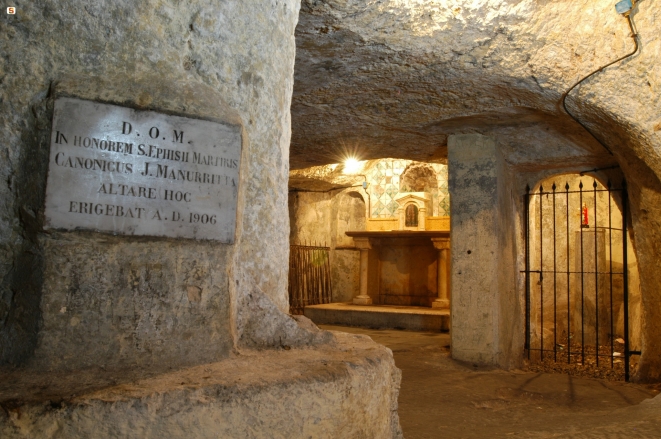Saint's crypt between history and tradition
The detention places of the martyr warrior
Stampace District. Via Sant’Efisio, number 34. A small dark wooden door, where there is a Latin sentence: Carcer Sancti Ephysi M. Nine meters below the road, through a steep ladder, you can come in an hypogeum that is totally dug on the calcareous rock. A rectangular room, whose ceiling is supported by two pillars.

According to tradition, this is the prison where the Saint warrior would have been closed and tortured before his transfer to Nora, where he was decapitated. Few suffused lights, half-light, silence and the heat of the rock. A Latin sentence quotes the Saint. The presence of a marble altar of the Seventeenth Century hits suddenly. It is in a good condition and aside, there is a small recess, closed by a gate. In the middle, there is a slight pillar, where, according to tradition, the Saint would have been linked and he would have been lashed because of he did not repudiate his faith.
The archaelogist Taramelli, after a study made in the hypogeum, trying to have some signs that were attributable to a hypotethical prison, immediately, rejected the hypothesis about the underground compartment, according to which, it was addressed to a tank for the collection of water or, maybe, a funerary crypt. The reason was that he did not find any signs of tombs formed on the walls. The discovery of some coins of that period proves that this place was ancient – the First Century A.D. Therefore, certainly, this place could be designated to some pagan cult, in this case, to goddess Isis cult. A well dug in the floor would be the evidence of that.
In the early years of the Seventeenth Century, when the interest of finding relics of saints and martyrs comes back in vogue, after a promotion of excavating, a skeleton was discovered and it was attributed to the martyr Edizio, a soldier who was a faithful fellow of Saint Efisio. A sentence present in a sheet proved that this skeleton effectively belonged to the martyr: Bonae Memoriae Editiu. That did not leave any doubts.

This place, between history and legend, always has its fascination. Currently, it his closed to the public and it is occasionally opened during the celebration of the Saint. In modern epoch, other underground caves and it were used by the citizens of Cagliari, as a shelter for escaping air bombardments during the Second World War.
Now, there is only this mystic unforgettable aura of the crypt. The memory of the martyrdom, of the punishment and of the flogging of Saint Efisio, happened in this dark underground, is always lively for the citizens of Cagliari and it is an essential stage for renewing the memory of the pains suffered by this saint warrior.